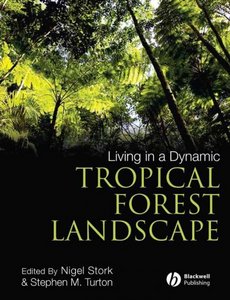Impacts of tropical cyclones on forests in the wet tropics of Australia
Turton, Stephen M., and Stork, Nigel E. (2008) Impacts of tropical cyclones on forests in the wet tropics of Australia. In: Stork, Nigel E., and Turton, Stephen M., (eds.) Living in a Dynamic Tropical Forest Landscape. Blackwell Publishing, Carlton, VIC, Australia, pp. 47-58.
![[img]](https://researchonline.jcu.edu.au/7413/2.hassmallThumbnailVersion/7413_Turton_and_Stork_2008_Cover.jpg)
|
Image (JPEG) (Book Cover)
- Cover Image
Download (66kB) |
|
|
PDF (Published Version)
- Published Version
Restricted to Repository staff only |
Abstract
[Extract] Disturbances both anthropogenic and natural, shape forest ecosystems by controlling their species composition, structure and functional processes (Dale et al.2001), The tropical forests of the Wet Tropics of north-east Australia have been moulded by their land use and disturbance history over many millennia but particularly over the past 100 years (see Pannell, Chapter 4; Turton, Chapter 5; Laurance & Goosem, Chapter 23, this volume). Forests of the Wet Tropics region are subjected to a plethora of natural disturbances, including fire, drought, native pathogen outbreaks, floods, occasional landslides and tropical cyclones. All these natural disturbances interact in complex ways with anthropogenic disturbances across the Wet Tropics landscape, such as land-use change resulting from forest conversion to agricultural systems, earlier logging practices, urban and peri-urban development and expansion of the tourism industry (see Part III this volume).
As in many parts of the non-equatorial tropics (Whitmore 1974; Boose et al. 1994), tropical cyclones (a.k.a. hurricanes and typhoons) are significant disturbance phenomena for forest ecosystems in the Wet Tropics of north-east Australia, especially those near the coast. For this reason, even continuous forests in the region have been described as hyper-disturbed ecosystems with patches of damaged forest constantly recovering from previous cyclonic events, often in concert with floods, droughts and fires (Webb 1958). Cyclones are part of the ecosystem dynamics of these forested landscapes and recovery of canopy cover following such events is often remarkably rapid, although forest structure and composition may take many decades to recover. The same cannot be said for fragmented forests in the Wet Tropics, located within either an agricultural or grassland matrix. These forest fragments are particularly vulnerable to impacts of tropical cyclones and their associated strong winds, largely due to their high forest edge to area ratios (Laurance 1991, 1997). These fragments are also more prone to post-disturbance weed invasion and bush fires than nearby areas of continuous forest.
| Item ID: | 7413 |
|---|---|
| Item Type: | Book Chapter (Research - B1) |
| ISBN: | 978-1-4051-5643-1 |
| Keywords: | rain forests; disturbance; frequency; recover; intensity; conservation |
| Date Deposited: | 15 Jan 2010 03:55 |
| FoR Codes: | 05 ENVIRONMENTAL SCIENCES > 0501 Ecological Applications > 050104 Landscape Ecology @ 40% 05 ENVIRONMENTAL SCIENCES > 0502 Environmental Science and Management > 050202 Conservation and Biodiversity @ 30% 04 EARTH SCIENCES > 0499 Other Earth Sciences > 049999 Earth Sciences not elsewhere classified @ 30% |
| SEO Codes: | 96 ENVIRONMENT > 9605 Ecosystem Assessment and Management > 960506 Ecosystem Assessment and Management of Fresh, Ground and Surface Water Environments @ 50% 96 ENVIRONMENT > 9603 Climate and Climate Change > 960399 Climate and Climate Change not elsewhere classified @ 50% |
| Downloads: |
Total: 1155 Last 12 Months: 4 |
| More Statistics |




